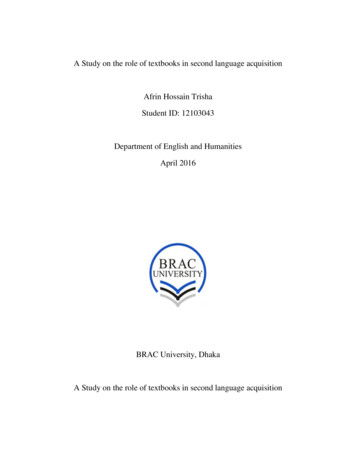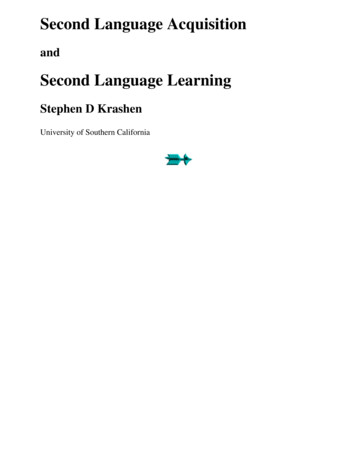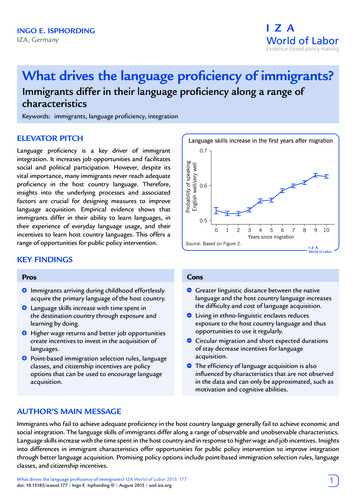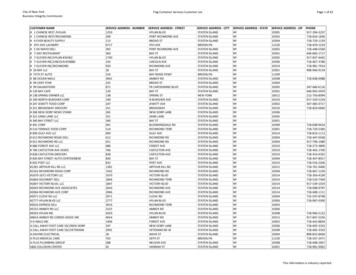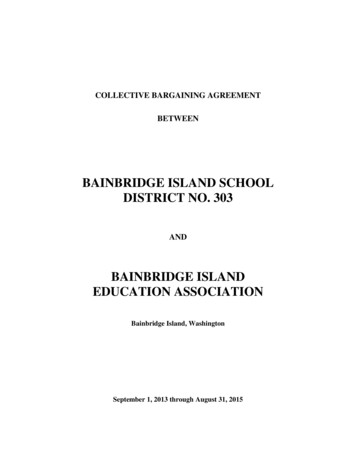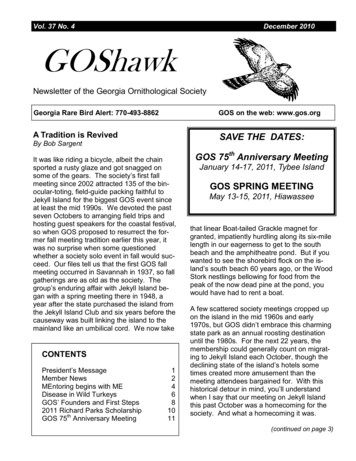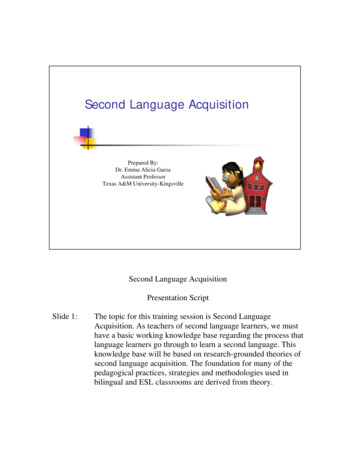
Transcription
Second Language AcquisitionPrepared By:Dr. Emma Alicia GarzaAssistant ProfessorTexas A&M University-KingsvilleSecond Language AcquisitionPresentation ScriptSlide 1:The topic for this training session is Second LanguageAcquisition. As teachers of second language learners, we musthave a basic working knowledge base regarding the process thatlanguage learners go through to learn a second language. Thisknowledge base will be based on research-grounded theories ofsecond language acquisition. The foundation for many of thepedagogical practices, strategies and methodologies used inbilingual and ESL classrooms are derived from theory.
What is SecondLanguage Acquisition?In second language learning, language plays aninstitutional and social role in the community. Itfunctions as a recognized means of communicationamong members who speak some other language as theirnative tongue.In foreign language learning, language plays no majorrole in the community and is primarily learned in theclassroom.The distinction between second and foreign language learningis what is learned and how it is learned.Slide 2:Learning a second language requires:1. formal language instruction in an academic setting;2. interactions with the second language outside of theclassroom;3. pedagogical practices, strategies and methodologies whichfacilitate second language learning (how); and4. teaching the four language skills: listening, speaking,reading, writing along with comprehension and thinking(what).
Slide 3:The study of second language acquisition involves:1. how second languages are learned ( the process);2. how learners create a new language system with limitedexposure (interactions);3. language proficiency levels (competence and performanceof the language); and4. why some learners achieve native-like proficiency.
How Do Learners Acquire aSecond Language?Learners acquire a second language by making use ofexisting knowledge of the native language, generallearning strategies, or universal properties of languageto internalize knowledge of the second language.These processes serve as a means by which thelearner constructs an interlanguage (a transitionalsystem reflecting the learner’s current L2 knowledge).Communication strategies are employed by thelearner to make use of existing knowledge tocope with communication difficulties.Slide 4:Learners acquire a second language by drawing on theirbackground experiences and prior knowledge in their firstlanguage. They experiment with the second language by usingfeatures found in their first language which are similar to thosein the second language. This dependence on the first languageserves to help the learner construct an interlanguage, atransitional system consisting of the learner’s current secondlanguage knowledge. Communication strategies help thelearners use what they already know to overcome breakdownsin communication.
Slide 5:Individual differences affect second language acquisition.These differences may be developmental, cognitive, affective orsocial. There are factors that are fixed which we cannot controlsuch as age and language learning aptitude. There are somevariable factors such as motivation which are controlled bysocial setting and the course taken for developing the secondlanguage.Teachers need to know that variable factors are controlledthrough the learning environment, by knowing their students’cognitive styles, their learning preferences, how they teach, andwhat they teach.
Slide 6:There are many different types of learner strategies whichteachers need to be aware of in order to understand thestrategies children bring with them and how they learn best.Language learners may need to be taught strategies for relatingnew knowledge to prior knowledge, for organizing informationmore effectively and for seeking opportunities forcommunicating with target language speakers.
Slide 7:Researchers identified a natural order of strategies fordeveloping a second language. The order of development startswith the very simple imitation of a word or language structure,to self-talk, to self-correcting, and to role-playing. Anawareness of this natural order can help teachers of secondlanguage learners plan lessons to facilitate language learningand increase the learners’ self-esteem and self-confidence.
Slide 8:There are several theories of second language acquisition whichhave provided information on how second languages arelearned. The Universalists studied a wide-range of languages tofind out how languages vary and what makes them vary. Theylooked at language patterns, language universals (features oflanguage which are common across many languages) as well asother properties of language.
Slide 9:Universalists also claimed that language is acquired throughinnateness (nature) and that certain conditions trigger thedevelopment of language (nurture). The search for meaning isinnate. Activities and instructional materials need to bepresented in a meaningful, relevant and interesting manner inorder to allow students to make language learning connections.
Slide 10:Behaviorists claimed that learners learn by undergoing trainingand practice through a series of stimulus and response chainsand operant conditioning. The environment provides thestimulus and the learner provides the response. According tothe Behaviorist theory, reinforcement motivates the formationof a language habit.
Behaviorist Theory(Continued)TheoryWhen the learner learns a language, this learning includes a set of stimulusresponse-reward (S-R-R) chains.Imitation provides the learner with a repertoire of appropriate, productiveresponses. The learner learns to imitate or approximate the productiveresponses provided by the environment.The characteristics of human and non-human learners include the ability to:Slide 11:1.respond to stimuli in a certain way;2.intuitively evaluate the reward potential of responses;3.extract the important parameters that made up the stimulus response(positive reward chains); and4.generalize these parameters to similar situations to form classes ofS-R-R chains.Language learning requires effort and practice. Behavioristsfurther claimed that learners imitate or approximate productiveresponses. For instance, learning how to write is not universalacross cultures because some cultures do not have a history ofwritten language, therefore learning how to write involves aconscious effort and specific training, as well as a willingnessto learn by trial and error. Responding to stimuli in this instanceis critical in order for writing to take place.
Slide 12:Nativists claimed that language learning is biologicallydetermined. Each person is born with an innate ability to learnlanguage. The basic innate language learning capacities arereferred to as the Language Acquisition Device (LAD). Thisview asserts that the environment only serves to trigger theLanguage Acquisition Device (LAD) which determines whatchildren acquire. Children acquire much of their languageability before coming to school, thus supporting the innatestructures argument.
Nativist Theory(Continued)TheoryMcNeill (1966) described the LAD as consisting of four innate linguisticproperties:1.the ability to distinguish speech sounds from other sounds in the environment;2.the ability to organize linguistic events into various classes that can be refined later;3.knowledge that only a certain kind of linguistic system is possible and that other kindsare not; and4.the ability to engage in constant evaluation of the developing linguistic system in orderto construct the simplest possible system out of the linguistic data that are encountered.Nativists have contributed to the discoveries of how the system of childlanguage works. Theorists such as Chomsky, McNeill, and others helpedus understand that a child’s language, at any given point, is a legitimatesystem in its own right.Slide 13:The Nativists also contend that learners actively constructgrammar for themselves by actively listening to the languagearound them and trying to determine the patterns in theutterances. Learners progress through language in predictablestages. The learner will not respond to error correction if he/sheis not developmentally ready.
Slide 14:Cognitivists claimed that the conditions for learning languageare the same conditions that are necessary for any kind oflearning. They believed that human beings have the capacity fordeveloping logical thinking. Acquiring knowledge is acognitive process which involves automatic processing(rountinzed) and controlled (temporary) learning.
Cognitivist Theory(Continued)TheoryLanguage Learning as a Cognitive Process1.Learning a language involves internal representations that regulate and guide performance.2.Automatic processing activates certain nodes in memory when appropriate input ispresent. Activation is a learned response.3.Memory is a large collection of nodes.4.Controlled processing is not a learned response. It is a temporary activation of nodes in asequence.5.Skills are learned and routinized only after the earlier use of controlled processes havebeen used.6.Learner strategies contain both declarative knowledge i.e. knowing the ‘what’ of thelanguage-internalized rules and memorized chunks of language, and procedural knowledgei.e. know the ‘how’ of the language system to employ strategies.Slide 15:The Cognitive theory underscores the fact that the learnerbrings an innate mental capacity to the learning task. He/shealso brings perceptions of relationships between what he knowsand what he/she needs to know. Learner strategies are used forlearning the rules of a language and how to use the language fordifferent audiences and purposes.
Theories of Second LanguageAcquisition (ContinuedTheorySocial Interactionist Theory supports the view that thedevelopment of language comes from the early interactionsbetween infants and caregivers.Social interactionists stress: the importance of a child’s interactions with parents and other caregivers;the importance of “motherese”;contributions of context and world knowledge; andthe importance of goalsGlew (1998) claims that learners have to be pushed in their negotiation ofmeaning to produce comprehensible output. The classroom context needs toprovide adequate opportunities for target language use to allow learners todevelop competence in the target language.Slide 16:Social interactionists believe that human language emergedfrom the social role that language plays in human interactions.They further believed that the environment plays a key role andthat adults in the child’s linguistic environment are instrumentalin language acquisition. Language learners need manyopportunities for using the target language in order to developcompetence.
Slide 17:Social interaction is the key to language processing. Input fromthe social interactions provides a model for negotiationopportunities. Vygotsky (1978) believed that learners bring twolevels of development to the learning: an actual developmentallevel and a potential developmental level. These two levels arereferred to as the Zone of Proximal Development. Learners canmove from actual development to proximal developmentthrough social interactions with others.
Slide 18:Krashen proposed five hypotheses for second languageacquisition. He explored the notion that acquisition is differentfrom learning because one takes place in a natural environmentwhile the other takes place in an academic setting. He furtherclaimed that we learn language in a predictable order. Somelanguage structures are learned earlier than others. The monitoris the self-correcting mechanism that learners use to edit whatthey say before they speak or write. The learner can overuse themonitor and stifle communication.
Slide 19:Krashen proposed that when learners are provided withcomprehensible input they acquire more. When the learner’saffective filter is up, this means that information is not reachingthe learner. This may be because of fear, anxiety or low selfconfidence in language learning. The ideal situation is for thefilter to be down so that the language acquisition device canreceive the input necessary for language acquisition.
Cummin’s Second LanguageFrameworkCummins makes a distinction between social language andacademic language.1. Social language refers to the everyday conversational language which is supportedby the use of illustrations, realia, demonstrations, etc. (Context Embedded). Studiesshow that language learners acquire social language in approximately two years.Social language deals with the here-and-now language, therefore second languagelearners tend to acquire it faster.2. Academic language is the language of school tasks which is more abstract anddecontextualized (Context Reduced).Some second language learners who develop fluent spoken English have difficulties inreading and writing because they may be at different levels of proficiency while they aremoving from social language (BICS) to academic language (CALP). It takes between fiveto seven years for second language learners to acquire academic language.Slide 20:James Cummins developed a framework for second languageacquisition that involves the identification of both social andacademic languages. The basic interpersonal communicationskills are acquired from everyday use of the language and aresupported by cues in the environment (context-embedded). Thecognitive academic language proficiency is more abstractlanguage which is not supported by environmental cues(context-reduced).
Slides 21-22: Context-embedded tasks are for the most part cognitivelyundemanding because learners are able to depend on cues forassistance. There are some tasks that are context-embedded,more complex and impose cognitive demands. The learners inthese situations can still rely on environmental cues for help.
Slides 23-24: Context-reduced tasks can be both cognitively undemandingand cognitively demanding as well. Cognitively undemandingtasks are simple to carry out but do not contain environmentalcues i.e. reading for personal purposes. Cognitively demanding,context-reduced tasks are more abstract and decontextualized.
Slides 25-26: The components of communicative competence include:1) grammatical competence which is knowing the structure ofthe language;2) sociolinguistic competence which involves the useof the language for different audiences, purposes and norms ofcommunication;3) discourse competence which includes combing andconnecting utterances both spoken and written; and4) strategic competence which involves using language tomeet communication goals.
Slide 27:Competence is the underlying knowledge which is the mentalrepresentation of linguistic rules. This knowledge is nonobservable because it is internal. Performance is the overtlyobservable production of competence (comprehension andproduction of language).
Slide 28:The three general principles of language learning include: 1) thelaw of exercise-active and repeated responses to stimuli(practice); 2) the law of effect-reinforcing learner responses(providing immediate corrective feedback); and 3) the principleof shaping-learning language through learning chunks (bit-bybit).
Slide 29:These principles operate under the assumption that languagelearning is the formation of habit. The learner’s automaticresponses were prompted by stimuli. Interesting and motivatingstimuli turns responses into automatic, routinized learning. Thelevel of difficulty required to learn a second language dependson the amount of time it takes to learn a second languagepattern. The time from which controlled responses (short-term)turn into automatic responses (long-term) is dependent onlearner differences, learning conditions, and teaching pedagogy.
Input and InteractionL2 acquisition can only take place when the learner has access to input in the second language.This input may come in written or spoken form.Spoken input occurs in face-to-face interactions. Non-reciprocal discourse includes listening tothe radio or watching a film.Behaviorists claim that presenting learners with input in the right doses and then reinforcingtheir attempts to practice them can control the process of acquisition.Chomsky pointed out that in many cases there was a very poor match between the kind oflanguage found in the input that learners received and the kind of language they themselvesproduced.Comprehensible input (Krashen’s, 1985 Input Hypothesis) proposed that learners acquiremorphological features in a natural order as a result of comprehending input addressed to them.Long (1981a) argued that input which is made comprehensible by means of the conversationaladjustments that occur when there is a comprehension problem is especially important foracquisition.Swain (1985) proposed the comprehensible output hypothesis which states that learners needopportunities for “pushed output” in speech or writing that makes demands on them for correctand appropriate use of the L2.Slide 30:Input and interaction are very important factors in secondlanguage acquisition. Second language acquisition can onlytake place when the learner has access to input in the targetlanguage. Teachers can provide comprehensible input in theirinstructional delivery coupled with opportunities forinteractions.Adjustments are made in order to facilitate the comprehensionof messages. Just as important is comprehensible output.Learners need to be given opportunities to produce spoken orwritten discourse which forces them to use correct andappropriate use of the second language.
The Role of the Native Language inSecond Language AcquisitionLanguageTrans ferThe role of native language in second language acquisition has come to be known as“language transfer.”It has been assumed that in a second language learning situation learners rely extensivelyon their native language.According to Lado (1957) individuals tend to transfer forms and meanings, thedistribution of the forms and meanings of their native language and culture to the foreignlanguage and culture.This transfer is productive when the learner attempts to speak the language.This transfer is receptive when the learner attempts to grasp and understand the languageand culture as practiced by native speakers.Lado’s work and much of the work of that time (1950’s) was based on the need toproduce pedagogically relevant materials. A contrastive analysis of the native languageand the target language was conducted in order to determine similarities and differencesin the languages.Slide 31:The first language has a distinct role in second languageacquisition. When language learners have a strong linguisticand communicative foundation in their native language, thenthe process of second language acquisition involves languagetransfer. Learners transfer forms and meanings as they attemptto speak or write the second language.Transfer takes on a receptive role when the learners listen tonative speakers of the language and try to understand what isbeing said. Similarities in the two languages are transferredpositively (language facilitation), while differences cause a nonproductive transfer (language interference).
Framework forExplaining L1 TransferLanguageTrans ferThe L1 system is used for both comprehension and production.The interlanguage system is also used in comprehending andreceiving messages.The L1 system is used in hypothesis construction responsible forinterlanguage development.Comprehensible input serves as a major source of information forhypothesis construction.L2 output may be used for hypothesis construction.Slide 32:Language learners rely on their first language to producelanguage and to comprehend it. Hypotheses construction oflanguage comes when learners manipulate and test languageforms to further their interlanguage, the stages of developmentbetween L1 and L2. The second language output helps thelearner test hypotheses of how language works and helps themconstruct new ones. Teachers provide comprehensible input inorder to help learners acquire information for hypothesesconstruction.
Slide 33:Language transfer is a cognitive process which involves the strategic useof the first language in learning the second language. The flexible thinkingthat occurs in the learner’s mind is representative of theinterconnectedness between the two languages. Bi-cognitive thinkingoccurs spontaneously and with great ease. Learners think in their firstlanguage, transfer that thinking into the second language and then producethe utterances that meet the communication situation.There is a distinction between transfer experienced for communicationpurposes and transfer experienced for second language learning. Firstlanguage transfer helps the learner receive and produce messages forcommunication purposes. Transfer in learning situations happens when thelearner uses the first language to formulate hypotheses about secondlanguage rules.
LanguageLanguage TransferTrans ferWhere the two languages were identical, learning could take place throughpositive transfer to the native-language pattern.Where the two languages were different, learning difficulty arose and errorsoccurred resulting from negative transfer.Chomsky (1959) set in motion a re-evaluation of many of the behavioristsclaims. This re-evaluation included area such as:the dangers of extrapolating from laboratory studies of animal behaviorto the language behavior of humans were pointed out;2.the terms stimulus and response were exposed as vacuous wherelanguage behavior was concerned;3.analogy could not account for the language user’s ability to generatetotally novel utterances; and4.studies of children acquiring their L1 showed that parents rarelycorrected their children’s linguistic errors, thus casting doubt on theimportance of reinforcement in language learning.All this led to the reconsideration of the role of L1 in L2 learning.1.Slide 34:When language features in the two languages are similar,positive transfer from the first language to the second languageoccurs. When language features in the two languages aredifferent, learning difficulties and errors happen. This transferprocess made it evident to researchers that the native languagedefinitely plays a major role in second language acquisition.
The Nature of theInterlanguage ContinuumCognitive theories of interlanguage claim that with the assistance oflearning strategies, learners build mental grammars of the secondlanguage.Learners draw on the rules they have constructed to interpret andproduce utterances.Learner’s utterances are only erroneous with reference to the targetlanguage norms, not to the norms of their own grammars.The interlanguage continuum consists of a series of overlappinggrammars. Each share some rules with the previously constructedgrammar, but also contains some new or revised rules.A rule has the status of a hypothesis.Slide 35:The implication of the interlanguage continuum for teachers isthat with assistance from learning strategies, learners are able tobuild mental grammars (rules) of the second language. Thecontinuum represents different interlanguage stages(overlapping grammars) that the learners go through to use therules they have learned to interpret and produce speech. Rulesare classified hypotheses because the learner tests certainlanguage rules in his/her development.
Selinker’s InterlanguageTheorySelinker’s Interlanguage Theory maintains the separateness of a second language learner’s system and gives the system a structurallyintermediate status between the native and target languages.According to Selinker, second language learners are producing their own self-contained linguistic system. The system is not a native languageor target language system, rather it falls between the two.Stages of Interlanguage Development include:1) random errors (presystematic);2) experimentation and inaccurate guessing;3) emergent-growing in consistency in linguistic production;4) backsliding-appears to have grasped but later regressed and unable to correct errors;5) systematic stage-ability to correct errors on their own; rules may not be well-formed but display more internal self-consistency;6) stabilization-few errors are made, have mastered the system to the point of fluency; and7) intralingual-inconsistencies within the target language; Global errors-affect meaning;local errors-close similarities in word form (i.e.spelling).Interlanguage ContinuumInterlanguage StagesL1L2/ / / / / / / / /BasilangMesolangAcrolangSlide 36:Each of the stages of the interlanguage continuum representseach grammar that the learner builds which represents morecomplexity as he/she moves on the continuum. Secondlanguage learners begin in their first language and as teachersprovide the formal and informal second language instruction,learners move forward in their development. When learnersencounter difficulties in any of their interlanguage stages, theycan fossilize (learning stops at some given point) or they mayexperience backsliding (regression).The continuum can be related to language learner categoriesused for identifying bilingual/ESL students. Basilang isequivalent to the beginner; mesolang is the category of anintermediate learner; and acrolang is the category for theadvanced learner.
Slide 37:The identification of errors that language learners make isimportant in order to understand the source of errors and thecorrective measures teachers can offer. Errors happen whenlearners lack knowledge of second language rules, whilemistakes occur when learners are unable to perform theircompetence (underlying knowledge that is non-observable).Overt errors are deviations in form and covert errors are thosethat are well-formed but do not communicate what the learnerintended.
Learner ErrorsError Analysis is used for examining errors as a way of investigating learningprocesses.Much of the early work on learner errors focused on the extent to which L2acquisition was the result of L1 transfer or creative construction (construction ofunique rules similar to those which children form in the course of acquiring the nativelanguage).The presence of errors that mirrored L1 structures was taken as evidence of transfer(interlingual), while those errors similar to those observed in L1 acquisition wereindicative of creative construction (intralingual).The study of learner errors showed that although many errors were caused bytransferring L1 habits, many more were not.It was found that learners went through stages of acquisition and the nature of errorsvaried according to their level of development.Error analysis could not show when learners resorted to avoidance and it ignored whatlearners could do correctly.Slide 38:For teachers of English language learners, it is important tounderstand the role of errors in second language learning. Erroranalysis is important because it gives us the opportunity toexamine learner errors and determine if errors are aconsequence of first language interference or not. Implicationsfor teachers come in planning instruction that addresses patternsin errors made by students experiencing language interference,grouping practices to target the identified errors, andinstructional methodologies and strategies for helping learnersovercome some of their errors.
Slide 39:Errors made by a language learner can give teachers insight asto how much knowledge the learner has in the second language.They are a means of diagnosing progress or lack of progress insecond language development. Errors are to be seen as part of aprocess of second language acquisition not just as the result ofimperfect learning.
Slide 40:Errors are systematic and will occur until the language learnerrecognizes them and corrects them. If communication is clear,even when learners produce errors such as “no want” then theerror is in the language structure and not in the learner’s system(interlanguage).
Slide 41:Contrastive analysis helps teachers understand potential errors languagelearners make. This understanding will allow teachers to identify whatneeds to be learned and what is already in the learner’s system.What needs to be learned will be the focus of instruction and what isalready learned will be the knowledge the learner brings to the learningsituations.The pedagogical materials that resulted from contrastive analysis werebased on the claim that language is a habit; language learning involves theestablishment of a new set of habits; the native language interferes withthe reception and production of a second language; and accounting forerrors involves considering differences between the first and the secondlanguages. The greater the differences the more errors will occur; anddifficulty and ease in learning a second language are determined bydifferences and similarities between the two languages in contrast.
Language Acquisition for School:The Prism ModelThomas & Collier, 1997 L1L2cAademicelevDotenpmL1 SocialL2LanguageandCulturalProcessesDevelopmentL1 L2 Cognitive DevelopmentSlide 42:Thomas and Collier (1997), proposed the Prism Model ofLanguage Acquisition for School. This model includes first andsecond language cognitive development, academicdevelopment, language development as well as social andcultural processes.
Slide 43:The cognitive development component is a subconsciousprocess that is developmental. Thought processes are builtthrough interactions. It is critical that cognitive developmenttake place in the first language so that the foundation is strongand positive transfer of skills and concepts occurs.
Slide 44:Academic knowledge, concepts and skills transfer from the first to thesecond language. In order to make the necessary instructional adjustments,teachers need to provide instruction in the learners’ first language and astrong English as a Second Language component during t
In foreign language learning, language plays no major role in the community and is primarily learned in the classroom. The distinction between second and foreign language learning is what is learned and how it is learned. Slide 2: Learning a second language requires: 1. formal language instruction in an academic setting; 2.
